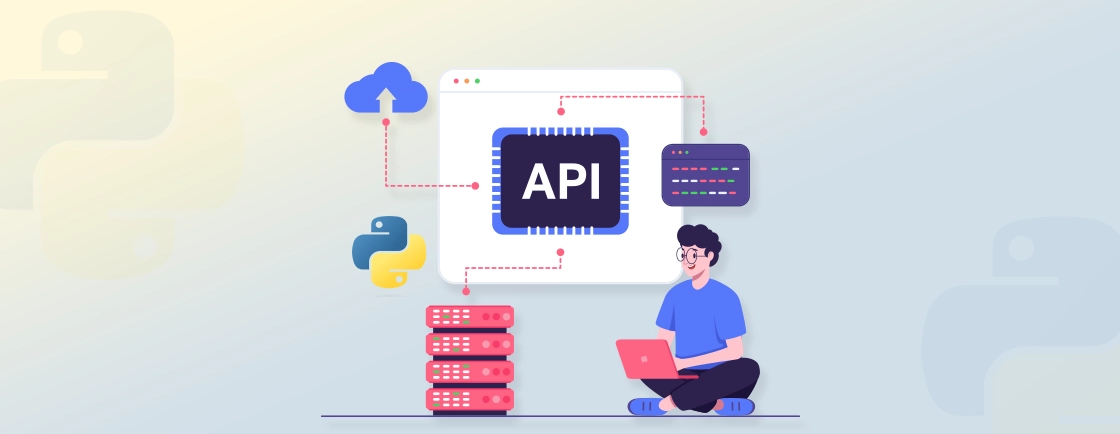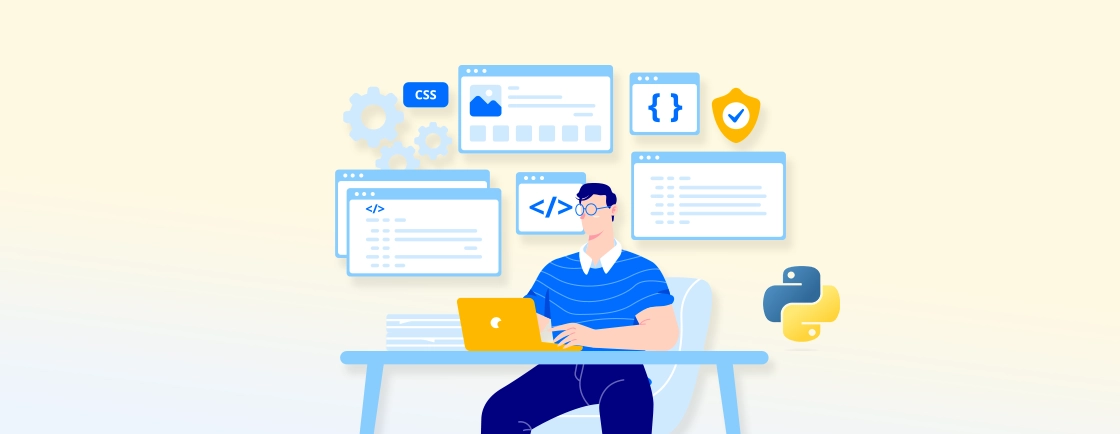Table of Contents
In 2025, Python continues to be a dominant force—ranking among the top programming languages globally—thanks to its clean syntax, versatility, and vibrant ecosystem that includes frameworks powering everything from Reddit and Spotify to AI-driven web APIs. Choosing the right framework, however, can be a game-changer for speed, scalability, and developer experience.
In this guide, we’ve curated and compared the latest, most widely adopted Python frameworks—including full-stack workhorses, lightweight microframeworks, and async-first tools—to help you identify the best match for your project. Whether you’re building a dynamic web app, a performant API, or an event-driven service, you’ll find a framework that streamlines development without compromising flexibility.
Let’s first understand the meaning of the Python framework.
What is a Python Framework?
A Python framework is a pre-built collection of modules and packages that provides developers with a structured foundation to build applications. Instead of coding every feature from scratch, frameworks handle common tasks like URL routing, database interactions, security, and request handling.
This not only saves development time but also ensures consistency, scalability, and maintainability across projects. Python frameworks generally fall into three categories:
- Full-Stack Frameworks – Provide everything needed for large-scale applications (e.g., Django).
- Microframeworks – Lightweight and flexible, ideal for small apps or APIs (e.g., Flask).
- Asynchronous Frameworks – Designed for high-performance apps that handle many requests at once (e.g., FastAPI).
Types of Python Frameworks
Python frameworks fall into three main categories: Full-stack, Micro, and Asynchronous frameworks. Each type serves specific use cases, from building complex web applications to creating lightweight APIs. Let’s explore the key differences and use cases for each:
1. Full-Stack Frameworks
Full-stack frameworks offer a comprehensive solution with built-in tools and features for almost every aspect of web development, including database management, templating, authentication, and admin panels.
These frameworks are ideal for developers who need an all-in-one solution for building large, complex applications. They minimize the need for third-party tools and accelerate development by offering out-of-the-box solutions.
Popular examples:
- Django – Known for its “batteries-included” philosophy, Django is one of the most popular full-stack frameworks, providing everything you need to build robust web applications quickly.
- Web2py – Another option, ideal for quick prototyping and deployment.
Best for: Large-scale web apps, enterprise-level projects, applications requiring rapid development.
2. Microframeworks
Microframeworks provide just the essentials to get your app up and running. These lightweight frameworks give developers more control over architecture and libraries, enabling them to handpick components for maximum flexibility.
Because they don’t impose any additional structure, microframeworks are often favored by developers who need minimalism or are working on small projects.
Popular examples:
- Flask – One of the most popular microframeworks, Flask is known for its simplicity and flexibility, making it great for APIs and small-scale applications.
- Bottle – A minimalistic framework that packs everything into a single file. Perfect for simple apps or APIs with minimal overhead.
Best for: Small projects, APIs, prototypes, when flexibility is key.
3. Asynchronous Frameworks
Asynchronous frameworks are optimized for high-performance, real-time applications that need to handle thousands of concurrent requests simultaneously. They leverage Python’s async/await syntax, making them ideal for applications like chat apps, microservices, and systems that require low-latency operations.
These frameworks offer excellent performance when dealing with real-time data and web applications where speed is critical.
Popular examples:
- FastAPI – An async-first framework that has gained a lot of popularity for its blazing fast performance and support for auto-generated API docs.
- Tornado – Well-suited for web sockets, long polling, and real-time applications that need to handle long-running requests efficiently.
- Sanic – A high-performance framework for building fast APIs, designed with asynchronous support at its core.
Best for: Real-time applications, APIs with heavy I/O tasks, microservices, handling large volumes of requests.
15 Best Python Frameworks for Web Development
Python’s flexibility and ease of use make it one of the top choices for web development. Whether you’re building a simple REST API, a complex CMS, or a real-time application, choosing the right Python framework is key to success. Here’s a look at 15 of the best Python frameworks that can help streamline your development process.
1. Flask
Flask is a minimalist microframework perfect for small to medium-sized projects. It offers flexibility by allowing you to choose your extensions, making it ideal for REST APIs, rapid prototypes, and smaller applications. Its simplicity makes it a favorite among developers at all skill levels.
Key Features:
- Lightweight with minimal boilerplate.
- Extensible via numerous extensions (e.g., SQLAlchemy, Flask-Security).
- Built-in development server & debugger.
- Jinja2 templating engine.
- RESTful request handling.
2. Django
Django is a comprehensive, full-stack framework often described as “batteries-included”. It comes with an ORM, admin panel, authentication, and much more out of the box, allowing developers to focus on business logic rather than infrastructure. It’s perfect for scalable web apps, such as content management systems (CMS) and eCommerce platforms.
Key Features:
- Full-featured (ORM, admin panel, authentication).
- Secure with built-in protections (e.g., CSRF, SQL injection).
- Django REST Framework (DRF) for API support.
- MVT (Model-View-Template) architecture.
- Automatic admin interface for management.
3. Pyramid
Pyramid strikes a balance between flexibility and structure, supporting both simple apps and complex systems. It allows developers to pick only the components they need and scale the framework as the project grows. Ideal for building REST APIs and large applications that require custom configuration.
Key Features:
- Highly flexible; can be as minimal or full-featured as needed.
- Supports both SQL and NoSQL databases.
- Includes URL routing and templating.
- Built-in authentication and authorization.
- Scalable for large applications.
4. FastAPI
FastAPI is designed for building high-performance APIs with Python 3.7+. Its async capabilities, automatic Swagger/OpenAPI docs, and data validation using Pydantic make it an ideal choice for microservices and real-time applications. It’s one of the fastest Python frameworks available today.
Key Features:
- Extremely fast (ASGI support, based on Starlette).
- Auto-generated API documentation (Swagger & OpenAPI).
- Strong data validation using Pydantic.
- Asynchronous support for high concurrency.
- Easy dependency injection system.
5. PyTorch
Although not traditionally a web framework, PyTorch is a powerful library for machine learning and deep learning. It’s widely used for developing AI applications like computer vision, natural language processing (NLP), and neural networks, making it essential for data-driven web apps.
Key Features:
- Dynamic computation graphs (ideal for research).
- GPU acceleration (via CUDA).
- Strong tools for neural networks and deep learning.
- Python-first, easy debugging.
- Widely used in AI research by companies like Facebook, Tesla, and OpenAI.
6. TensorFlow
TensorFlow, developed by Google, is one of the leading frameworks for building machine learning models and neural networks. It’s designed for large-scale, enterprise-grade applications and can be deployed on mobile and edge devices using TensorFlow Lite.
Key Features:
- Static computation graphs (optimized for production).
- Scalable for large ML models.
- TensorBoard for model visualization.
- Deployable on mobile and edge devices (via TensorFlow Lite).
- Backed by Google’s ecosystem.
7. CherryPy
CherryPy is a minimalist, object-oriented web framework that enables developers to build web applications quickly and efficiently. It’s lightweight but still provides essential features like session handling, caching, and file uploads.
Key Features:
- Minimalist, yet powerful.
- Built-in HTTP server (HTTP/1.1-compliant).
- Thread-pooled web server.
- Easy integration with other applications via WSGI.
- Supports plugins for added functionality.
8. NumPy
NumPy is essential for scientific computing and data analysis in Python. It provides support for multidimensional arrays and mathematical operations, making it the backbone of many Python data science projects, including machine learning and engineering tasks.
Key Features:
- Efficient multidimensional arrays.
- Extensive mathematical and statistical operations.
- Integrates seamlessly with Pandas and SciPy.
- Optimized for performance and large data sets.
9. SciPy
Built on top of NumPy, SciPy extends its functionality with more advanced mathematical, scientific, and engineering functions. It’s widely used for optimization, signal processing, and other complex scientific tasks.
Key Features:
- Advanced mathematical operations for optimization, signal processing, etc.
- Built on NumPy, offering seamless integration.
- Linear algebra, statistics, and optimization.
- Widely used in engineering and physics.
10. Pandas
Pandas is the go-to library for data manipulation and analysis in Python. With DataFrame structures, it simplifies the handling of structured data, making it ideal for data science, finance, and analytics applications.
Key Features:
- DataFrame structures for easy data manipulation.
- Advanced handling of time-series data.
- Powerful tools for filtering, merging, and pivoting data.
- Integrates well with NumPy, Matplotlib, and other data science libraries.
11. Tornado
Tornado is an asynchronous framework optimized for high-performance applications. It can handle thousands of concurrent connections, making it ideal for real-time apps, WebSockets, and long-polling.
Key Features:
- Asynchronous networking for real-time apps.
- Built-in HTTP server.
- High performance under heavy traffic.
- Non-blocking I/O operations for efficiency.
12. Bottle
Bottle is an ultra-lightweight, single-file microframework with zero dependencies. Despite its simplicity, it offers essential features like routing, templating, and a built-in HTTP server, making it a great option for small projects and prototypes.
Key Features:
- Single-file microframework.
- Built-in HTTP server.
- Simple routing and templating.
- WSGI-compatible.
13. CubicWeb
CubicWeb is a semantic web framework that uses a component-based architecture, ideal for building data-centric applications with complex querying and RDF (Resource Description Framework) support.
Key Features:
- Semantic web framework (RDF, Linked Data).
- Reusable components (cubes).
- Built-in database with RQL and security.
- Highly modular for complex applications.
14. Dash
Dash is a Python framework for building interactive, data-driven web applications and dashboards. Powered by React.js, Dash allows you to create rich visualizations with minimal code, making it ideal for data analytics and business intelligence tools.
Key Features:
- Focused on data visualization and dashboards.
- React.js-powered UI with Python integration.
- Works with Plotly, Pandas, and NumPy.
- Easy to deploy with minimal dependencies.
15. Hug
Hug is designed for making API development simple, fast, and efficient. It allows developers to write APIs once and run them as a CLI, HTTP, or local library, minimizing overhead and maximizing performance.
Key Features:
- Optimized for API development.
- Write once, deploy anywhere (CLI, HTTP, or local).
- Automatic versioning and documentation.
- High performance with minimal boilerplate.
How to Choose the Right Python Framework
Choosing the right Python framework for your project is essential to its success. No single framework fits every application, so it is crucial to evaluate your needs based on the scope of the project, performance requirements, team expertise, and long-term goals.
Here’s a step-by-step guide on how to pick the framework that best suits your project:
1. Project Scope & Complexity
When selecting a framework, it’s essential to match its capabilities with the size and complexity of your project.
- Large, feature-rich applications: Django is ideal for these types of projects. Its “batteries-included” approach means it provides most of the necessary tools out-of-the-box, saving significant development time.
- Small projects or rapid prototypes: Flask and FastAPI offer lightweight structures that provide flexibility, allowing you to add features as needed without unnecessary overhead.
2. Performance Needs
Performance is a crucial factor, especially for high-traffic or real-time applications.
- High speed & concurrency: FastAPI is a great choice with its asynchronous (async) support, offering impressive performance for handling multiple requests concurrently.
- CPU-intensive tasks: For projects that require heavy computation, look for frameworks that support Cython integration or those optimized for parallel processing.
3. Development Speed
The speed at which your team can develop the project is another important consideration.
- Rapid development: Django speeds up development with its built-in tools like the admin panel and ORM, making it ideal for getting large applications off the ground quickly.
- Quick prototypes or MVPs: Flask and FastAPI require less setup, offering faster iteration for simple apps or minimum viable products (MVPs).
4. Scalability
As your application grows, you’ll need to ensure that your framework can scale efficiently.
- High-traffic applications: FastAPI and Tornado are built to handle high concurrency and real-time requests, making them perfect for scalable apps.
- Django can also scale but may require more optimization for handling large-scale traffic. Consider strategies like horizontal scaling for both small and large apps.
5. Learning Curve & Team Expertise
The complexity of the framework can affect your team’s productivity, especially in the early stages of development.
- Steep learning curve: Django offers a lot of built-in features, but this requires learning its conventions and structure.
- Easier for beginners: Flask has a minimalistic design, making it easier for newer developers to pick up quickly.
6. Ecosystem & Libraries
A rich ecosystem can save time and effort by providing ready-made solutions to common problems.
- Extensive libraries: Django boasts a rich ecosystem with a wealth of plugins like Django REST Framework for API development, as well as support for authentication, form handling, and more.
- Lighter ecosystems: Microframeworks like Flask rely on community-driven extensions and may require more customization for advanced features.
7. Community & Support
The community behind a framework plays a key role in troubleshooting and access to resources like documentation, tutorials, and forums.
- Large and active communities: Frameworks like Django and Flask have vast, thriving communities, making it easier to find solutions to problems and get help from experienced developers.
- Smaller frameworks: Niche frameworks may have fewer resources and slower response times to issues.
8. Security Requirements
Security should be a top concern, especially when dealing with sensitive user data.
- Built-in security: Django offers robust, built-in security features that protect against common vulnerabilities like SQL injection, CSRF, and XSS.
- For other frameworks: You’ll need to verify if they offer middleware or third-party plugins to secure your application.
9. Test & Prototype Before Committing
Before making a final decision, it’s a good idea to test at least 2-3 frameworks by building a small prototype. This will give you a better understanding of how well the framework fits with your project’s needs and your team’s workflow.
Let’s Summarize
Choosing the right Python framework ultimately depends on the type of web application or service you’re building. For full-fledged, feature-rich applications, Django is often the go-to framework. However, if you’re building lightweight applications or APIs, Flask and FastAPI provide the flexibility and high-performance capabilities needed to scale efficiently.
When it comes to data-driven applications, Pandas and PyTorch remain integral tools for data analysis and machine learning, while Dash makes interactive data dashboards simple to implement.
The key takeaway is this: match the framework to your project goals. Start with a lightweight solution and scale as your project grows, taking full advantage of Python’s expansive and versatile ecosystem.
If you are ready to bring your ideas to life, collaborating with experienced Python developers can ensure you choose the right tools, optimize your development process, and deliver a high-quality, scalable solution.
If you’re ready to bring your project to life, hire Python developers who can help you choose the right tools and deliver quality solutions.
FAQs on Best Python Frameworks
What’s the fastest Python web framework?
FastAPI and Tornado are among the fastest due to async support, while Django and Flask are slightly slower but more feature-rich.
Is Django good for REST APIs?
Yes, especially with Django REST Framework (DRF), but FastAPI or Flask may be simpler for API-only projects.
Can I use PyTorch and TensorFlow together?
Yes, some projects use PyTorch for research and TensorFlow for production deployment due to their complementary strengths.
Can I build machine learning models without TensorFlow/PyTorch?
Yes, Scikit-learn is sufficient for traditional ML, but PyTorch/TensorFlow are needed for deep learning.
Does Django work with NoSQL databases?
Django primarily supports SQL, but libraries like Django-Nonrel add NoSQL compatibility.
Python Solutions for Your Projects
Explore tutorials and resources to master Python for various applications.





